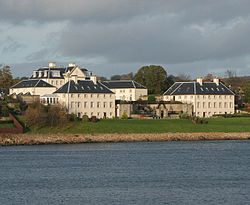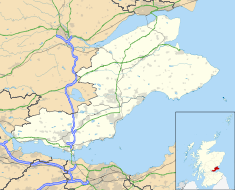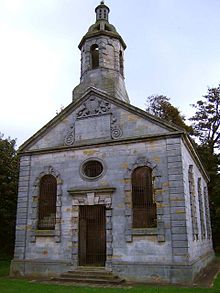- Donibristle
-
Donibristle The modern Donibristle House, with the 18th-century wings in frontLocation: Dalgety Bay, Fife, Scotland Coordinates: 56°01′53″N 3°20′57″W / 56.0315°N 3.3492°WCoordinates: 56°01′53″N 3°20′57″W / 56.0315°N 3.3492°W Built: circa 1700–1720 Built for: Earl of Moray Demolished: 1858 after fire Rebuilt: 1990s Architect: Alexander McGill Listed Building – Category A Designated: 24 November 1972 Reference #: 3647 Inventory of Gardens and Designed Landscapes in Scotland Criteria: Architectural Designated: 1987 Donibristle was a house and estate in Fife, Scotland, on the coast of the Firth of Forth. Only the wings of the house remain, within the modern settlement of Dalgety Bay: they are now protected as a category A listed building.[1] Donibristle was the scene of the killing of James Stewart, 2nd Earl of Moray, in 1592, which is remembered in the ballad "The Bonny Earl O'Moray".
History
Around 1540, James Stewart of Doune was made Commendator of Inchcolm Abbey, which is located on an island in the Firth of Forth. Donibristle was then a property of the abbey, and James used it as a residence.[1] In 1580, his son was raised to the peerage as Lord Doune. Lord Doune's son James Stewart married, in 1581, Elizabeth Stuart, 2nd Countess of Moray, and assumed, jure uxoris (in right of his wife), the title of the Earl of Moray. Moray quarelled with George Gordon, 1st Marquess of Huntly, and on on 7 February 1592 Huntly attacked and burned Donibristle. Moray attempted to flee but was caught and killed.
A new house was constructed around 1700, and around 1720 L-plan wings of three storeys were added, to the designs of Alexander McGill.[1] McGill also designed the mortuary chapel of the Earls of Moray on the estate, which is dated 1731 and is also category A listed.[2] In the late 18th century landscape gardener Thomas White laid out the parkland.[3] James Gillespie Graham prepared plans for Jacobean-style remodelling in the earlier 19th century. The main block of the house burned down in 1858.[1] The surviving wings are linked by a subterranean passage and a decorative wrought-iron screen, said to be the finest early 18th century wrought-iron screen still in existence in Scotland.[3]
During World War I the estate was used by the Royal Naval Air Service as an airfield, which was expanded during World War II as HMS Merlin. From 1962 the airfield and the rest of the estate was developed as Dalgety Bay, a privately-funded new town. Begun by Copthall Holdings, the site was taken over by the Scottish Homes Investment Company and construction continued into the 1970s.[4] In the late 20th century the wings of Donibristle House and the nearby stable block were restored as housing, and a new apartment building was erected in place of the main block of the house.
References
- ^ a b c d "Donibristle House: Listed Building Report". Historic Scotland. http://hsewsf.sedsh.gov.uk/hslive/hsstart?P_HBNUM=3647.
- ^ "Donibristle Chapel: Listed Building Report". Historic Scotland. http://hsewsf.sedsh.gov.uk/hslive/hsstart?P_HBNUM=3650.
- ^ a b "Donibristle House: Landscape Components". An Inventory of Gardens and Designed Landscapes in Scotland. Historic Scotland. http://www.historic-scotland.gov.uk/index/heritage/gardens/gardenssearchmoreinfo.htm?s=donibristle&r=&bool=0&PageID=2240&more_info=Landscape.
- ^ "Dalgety Bay". Fife Direct. Fife Council. http://www.fifedirect.org.uk/yourtown/index.cfm?fuseaction=town.display&town=D2647D9C-B6A4-47D0-9CC9115104EA65A2.
Categories:- Listed houses in Scotland
- Category A listed buildings in Scotland
- Inventory of Gardens and Designed Landscapes
- Listed buildings in Fife
- Demolished buildings and structures in Scotland
Wikimedia Foundation. 2010.



